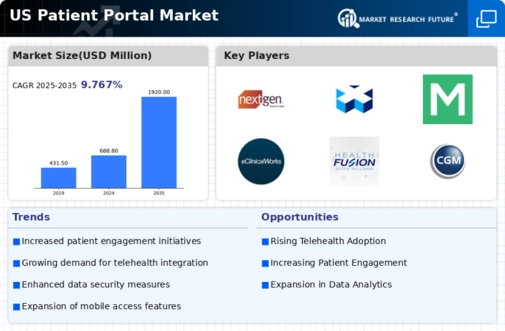The US Patient Portal Market has been experiencing significant growth and transformation as healthcare providers recognize the importance of enhancing patient engagement and improving the overall healthcare experience. Patient portals serve as a digital bridge between healthcare providers and patients, allowing them to access medical information, schedule appointments, communicate with providers, and manage their care more effectively. As the demand for patient-centered care continues to rise, various companies are competing to establish strong positions in this evolving market. The competitive landscape is characterized by a diverse range of participants, including large healthcare technology firms and specialized software providers.
Factors such as the quality of the user interface, integration capabilities with electronic health records, and overall patient satisfaction have emerged as critical determinants of success in the marketplace.
Allscripts Healthcare Solutions has carved out a robust presence in the US Patient Portal Market, driven by its commitment to providing comprehensive healthcare solutions. Its strengths lie in its extensive suite of products, which include innovative electronic health record systems, advanced analytics, and interoperability features that enhance patient engagement. Allscripts distinguishes itself through its user-friendly interfaces and the ability to integrate seamlessly with various healthcare systems, thus facilitating streamlined communication between patients and providers.
The company's focus on collaborating with healthcare organizations to deliver tailored solutions has further solidified its market position, enabling it to address the specific needs of different healthcare environments. As a result, Allscripts remains competitive by continually updating its offerings and investing in new technologies that improve patient access to information.
NextGen Healthcare, another significant player in the US Patient Portal Market, has developed a range of solutions designed to enhance patient interaction and streamline administrative processes. The company’s key products include electronic health records, practice management systems, and patient engagement tools that empower patients to take proactive roles in their healthcare journeys. NextGen Healthcare has effectively positioned itself by providing integrated solutions that cater to both providers and patients, fostering a holistic approach to care delivery. Its strengths are underscored by consistent innovation, including the implementation of telehealth capabilities and patient education resources.
Furthermore, NextGen Healthcare has engaged in strategic partnerships and acquisitions, enhancing its market presence and expanding its product offerings. This proactive approach enables NextGen to adapt to changing market dynamics and meet the growing demands for improved digital patient engagement within the US healthcare landscape.



















